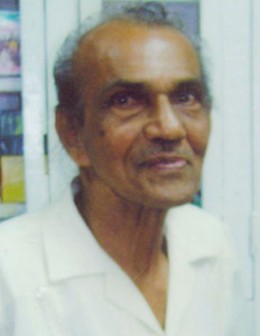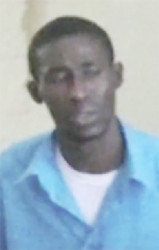Police witness Sailesh Roopnarine yesterday testified that prints found at the scene where 84-year-old drugstore owner Harold Rachpaul was murdered matched the fingerprints of the accused Orvin Kevin Roberts.
Roberts is on trial for the murder before Justice Navindra Singh and a 12-member jury at the High Court in Georgetown. The allegation against him is that between August 18 and 19, 2011, he murdered the octogenarian in the course or furtherance of a burglary.
He has denied the charge.

In his testimony, Roopnarine said that he assisted in investigations by taking fingerprint impressions from the accused after he had been contacted and taken into custody by police.
The witness told the court that the fingerprints he had taken from Roberts matched those that other ranks had lifted from Rachpaul’s 75 Robb Street, Lacytown apartment where he was murdered.
The fingerprinting form on which Roopnarine said he took Roberts’ prints, were tendered and admitted into evidence.
Asked under cross-examination by defence attorney Nigel Hughes if he works at the fingerprint branch, Roopnarine answered no; but said that he regularly takes fingerprints.
After examining the fingerprint form, Hughes quizzed the police witness extensively about a number of what he termed “distortions” which he observed on the said form.

Defence counsel questioned the witness about some “double prints” which he said he observed on the form, and asked whether he would agree that they were double prints, indicating that there were distortions.
Roopnarine repeatedly tried to give an explanation for why the impressions appeared to have been double-printed. Hughes however constantly admonished him to answer only the questions he had been asked. Eventually, the witness agreed with counsel’s suggestion that there were double prints and distortions on the form.
Referring to one of the 10 fingerprint impressions on the form, the witness also agreed with counsel that one print appeared to have been made, and then another impression over the very one.
Hughes had Roopnarine participate in an exercise where he asked him to place his thumb and index fingers over the respective fingerprint impressions which he said he took from Roberts, which were on the form.
After the witness carried out the exercise, he agreed that his fingers could not fit the respective impressions on the form, as those impressions were much larger than his actual fingers.
After asking his client to hold up his fingers for the court to see, Hughes then asked Roopnarine if his, (Roopnarine’s) fingers and Roberts’ fingers were not of “about the same size,” to which the police officer agreed.
Hughes had Roopnarine approach his client with the form to line-up Roberts’ fingers against the impressions. The policeman then agreed that the fingers of the accused did not fit the impressions on the form.
When further quizzed, the witness also agreed with defence counsel that all 10 finger impressions on the form, were much larger than his and Roberts’ actual fingers.
Under re-examination by state attorney Narissa Leander, Roopnarine when asked, explained the variation in size of the impressions on the form; to that of Roberts’ or even his actual fingers, were because of the “angle.”
He said that the angle from which he took Roberts’ prints, were different from the angle counsel made the demonstration when he asked him to do the exercise.
Questioned about the double prints and distortions, Roopnarine proceeded to tell Leander about prints being made too “light and was about to say that perspiration…,” when Justice Singh stopped him.
The judge told the witness not to speculate but to speak only to what he had personal knowledge of; asking him directly whether—as the person who took the prints, he knew what had caused the double prints and distortions, to which he responded in the negative.
The jury was allowed to enquire from the witness how he took the fingerprints.
Roopnarine then said that the accused was given a plain sheet of paper to wipe his fingers, after which each finger was rolled onto an ink pad, before being pressed unto the fingerprinting form.
Testifying at yesterday’s hearing also was grandson of the deceased, Vincent Rachpaul, who recalled making the discovery of his granddad’s lifeless body.
Asked by Hughes under cross-examination if he was questioned by the police to account for his whereabouts on the night of August 18, 2011 after he left his grandfather’s premises, Vincent said he could not recall.
He agreed with a suggestion from counsel that he saw no signs of forced entry at the scene.
After agreeing with Hughes that he had access to his grandfather’s premises and the dogs knew him, counsel then enquired from Vincent whether the police investigated him as being someone who may have killed his grandfather. This witness however said that he could not recall being investigated by the police as a possible suspect.
Eight of the 11 witnesses to be called by the state have so far testified.
The trial continues this morning at 9.









